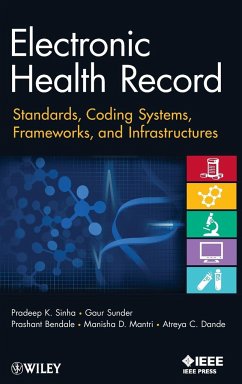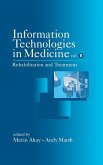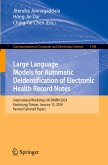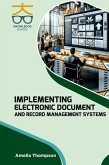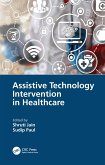Pradeep K. Sinha, Gaur Sunder, Prashant Bendale, Manisha Mantri, Atreya Dande
Electronic Health Record
Standards, Coding Systems, Frameworks, and Infrastructures
Pradeep K. Sinha, Gaur Sunder, Prashant Bendale, Manisha Mantri, Atreya Dande
Electronic Health Record
Standards, Coding Systems, Frameworks, and Infrastructures
- Gebundenes Buch
- Merkliste
- Auf die Merkliste
- Bewerten Bewerten
- Teilen
- Produkt teilen
- Produkterinnerung
- Produkterinnerung
Discover How Electronic Health Records Are Built to Drive the Next Generation of Healthcare Delivery The increased role of IT in the healthcare sector has led to the coining of a new phrase "health informatics," which deals with the use of IT for better healthcare services. Health informatics applications often involve maintaining the health records of individuals, in digital form, which is referred to as an Electronic Health Record (EHR). Building and implementing an EHR infrastructure requires an understanding of healthcare standards, coding systems, and frameworks. This book provides an…mehr
Andere Kunden interessierten sich auch für
![Information Technologies in Medicine, Volume II Information Technologies in Medicine, Volume II]() Metin Akay / Andy Marsh (Hgg.)Information Technologies in Medicine, Volume II183,99 €
Metin Akay / Andy Marsh (Hgg.)Information Technologies in Medicine, Volume II183,99 €![Large Language Models for Automatic Deidentification of Electronic Health Record Notes Large Language Models for Automatic Deidentification of Electronic Health Record Notes]() Large Language Models for Automatic Deidentification of Electronic Health Record Notes82,99 €
Large Language Models for Automatic Deidentification of Electronic Health Record Notes82,99 €![Implementing Electronic Document and Record Management Systems Implementing Electronic Document and Record Management Systems]() Amelia ThompsonImplementing Electronic Document and Record Management Systems74,99 €
Amelia ThompsonImplementing Electronic Document and Record Management Systems74,99 €![Assistive Technology Intervention in Healthcare Assistive Technology Intervention in Healthcare]() Assistive Technology Intervention in Healthcare175,99 €
Assistive Technology Intervention in Healthcare175,99 €![New Work Im Metaverse New Work Im Metaverse]() Andreas DrosteNew Work Im Metaverse19,50 €
Andreas DrosteNew Work Im Metaverse19,50 €![Crowdsourcing Crowdsourcing]() Jean-Fabrice LebratyCrowdsourcing186,99 €
Jean-Fabrice LebratyCrowdsourcing186,99 €![Mathematics for Informatics and Computer Science Mathematics for Informatics and Computer Science]() Pierre AudibertMathematics for Informatics and Computer Science186,99 €
Pierre AudibertMathematics for Informatics and Computer Science186,99 €-
-
-
Discover How Electronic Health Records Are Built to Drive the Next Generation of Healthcare Delivery
The increased role of IT in the healthcare sector has led to the coining of a new phrase "health informatics," which deals with the use of IT for better healthcare services. Health informatics applications often involve maintaining the health records of individuals, in digital form, which is referred to as an Electronic Health Record (EHR). Building and implementing an EHR infrastructure requires an understanding of healthcare standards, coding systems, and frameworks. This book provides an overview of different health informatics resources and artifacts that underlie the design and development of interoperable healthcare systems and applications.
Electronic Health Record: Standards, Coding Systems, Frameworks, and Infrastructures compiles, for the first time, study and analysis results that EHR professionals previously had to gather from multiple sources. It benefits readers by giving them an understanding of what roles a particular healthcare standard, code, or framework plays in EHR design and overall IT-enabled healthcare services along with the issues involved.
This book on Electronic Health Record:
Offers the most comprehensive coverage of available EHR Standards including ISO, European Union Standards, and national initiatives by Sweden, the Netherlands, Canada, Australia, and many others
Provides assessment of existing standards
Includes a glossary of frequently used terms in the area of EHR
Contains numerous diagrams and illustrations to facilitate comprehension
Discusses security and reliability of data
Hinweis: Dieser Artikel kann nur an eine deutsche Lieferadresse ausgeliefert werden.
The increased role of IT in the healthcare sector has led to the coining of a new phrase "health informatics," which deals with the use of IT for better healthcare services. Health informatics applications often involve maintaining the health records of individuals, in digital form, which is referred to as an Electronic Health Record (EHR). Building and implementing an EHR infrastructure requires an understanding of healthcare standards, coding systems, and frameworks. This book provides an overview of different health informatics resources and artifacts that underlie the design and development of interoperable healthcare systems and applications.
Electronic Health Record: Standards, Coding Systems, Frameworks, and Infrastructures compiles, for the first time, study and analysis results that EHR professionals previously had to gather from multiple sources. It benefits readers by giving them an understanding of what roles a particular healthcare standard, code, or framework plays in EHR design and overall IT-enabled healthcare services along with the issues involved.
This book on Electronic Health Record:
Offers the most comprehensive coverage of available EHR Standards including ISO, European Union Standards, and national initiatives by Sweden, the Netherlands, Canada, Australia, and many others
Provides assessment of existing standards
Includes a glossary of frequently used terms in the area of EHR
Contains numerous diagrams and illustrations to facilitate comprehension
Discusses security and reliability of data
Hinweis: Dieser Artikel kann nur an eine deutsche Lieferadresse ausgeliefert werden.
Produktdetails
- Produktdetails
- Verlag: Wiley & Sons
- 1. Auflage
- Seitenzahl: 376
- Erscheinungstermin: 17. Dezember 2012
- Englisch
- Abmessung: 240mm x 161mm x 25mm
- Gewicht: 730g
- ISBN-13: 9781118281345
- ISBN-10: 1118281349
- Artikelnr.: 34754913
- Herstellerkennzeichnung
- Libri GmbH
- Europaallee 1
- 36244 Bad Hersfeld
- gpsr@libri.de
- Verlag: Wiley & Sons
- 1. Auflage
- Seitenzahl: 376
- Erscheinungstermin: 17. Dezember 2012
- Englisch
- Abmessung: 240mm x 161mm x 25mm
- Gewicht: 730g
- ISBN-13: 9781118281345
- ISBN-10: 1118281349
- Artikelnr.: 34754913
- Herstellerkennzeichnung
- Libri GmbH
- Europaallee 1
- 36244 Bad Hersfeld
- gpsr@libri.de
PRADEEP K. SINHA, PhD, is the Senior Director (High Performance Computing) at the Centre for Develop- ment of Advanced Computing (C-DAC), India, and coordinator and mentor to several high-technology R&D groups there. GAUR SUNDER heads research and development at Medical Informatics Group (MIG) at C-DAC, India, and is a member of the eHealth Committee of the Bureau of Indian Standards and the National EHR Standards Committee of the Union Health Ministry of India. PRASHANT BENDALE is involved in the research and development of the distribution and integration model for building EHR stores at C-DAC. MANISHA D. MANTRI is involved in the research and development of an evolving EHR model, compliance to eHealth standards, and security policies for EHR systems at C-DAC. ATREYA C. DANDE is involved in the research and development of EHR standards, national EHR frameworks, distributed technologies, and optimal search algorithms in healthcare at C-DAC.
Preface XVII
Acronyms XXVII
PART ONE Introduction
1 Introduction to EHR 3
1.1 Introduction, 3
1.2 Definition of EHR, 4
1.3 Functions of EHR, 5
1.4 Significance of EHR, 6
1.5 Factors Affecting Implementation of EHR, 7
1.6 Role of Standards, 8
1.7 Role of Clinical Coding Systems, 9
1.8 Role of Standard Frameworks, 9
1.9 Case Studies of National EHR Implementations, 10
PART TWO EHR Standards
2 Standard for EHR Architecture Requirements 15
2.1 Introduction, 15
2.2 ISO/TS 18308 Requirement Specification, 16
2.2.1 Content Structure Model, 16
2.2.2 Inclusion of Clinical and Record Processes, 17
2.2.3 Content Exchange, 17
2.2.4 Privacy and Security, 17
2.2.5 Legal Considerations, 17
2.2.6 Ethical, Consumer/Cultural Aspects, 18
2.2.7 Future-proof Framework, 18
2.3 Discussion, 18
2.4 Conclusion, 20
3 Standard for Healthcare Concepts 23
3.1 Introduction, 23
3.2 CEN/TC EN 13940-1, 24
3.2.1 Actors in Continuity of Care, 24
3.2.2 Health Issues and Their Management, 25
3.2.3 Concepts Related to Responsibility, 25
3.2.4 Time-Related Concepts, 26
3.2.5 Concepts Related to Knowledge, Activities, and Decision Support, 27
3.2.6 Health Data Management, 28
3.3 CEN/TC prEN 13940-2, 28
3.3.1 Healthcare Process, 29
3.4 Discussion, 30
3.5 Conclusion, 32
4 Standard for EHR Functional Specifications 33
4.1 Introduction, 33
4.2 HL7 EHR-S Functional Model, 34
4.2.1 Functional Profiles, 34
4.2.2 Exchange, 36
4.2.3 Security/Privacy, 37
4.3 Comparison of HL7 EHR-S FM and ISO/TS 18308, 38
4.4 Discussion, 39
4.5 Conclusion, 40
5 Standard for EHR Communication 43
5.1 Introduction, 43
5.2 CEN/ISO EN 13606 Requirement Specification, 45
5.2.1 Part 1: Reference Model, 45
5.2.2 Part 2: Archetypes Interchange Specification, 46
5.2.3 Part 3: Reference Archetypes and Term Lists, 49
5.2.4 Part 4: Security, 49
5.2.5 Part 5: Exchange Models, 50
5.3 Discussion, 51
5.4 Conclusion, 53
6 Messaging Standard for Healthcare Data 57
6.1 Introduction, 57
6.2 HL7 v2.x, 58
6.2.1 Message Structure, 60
6.2.2 Auxiliary Messaging Protocols, 61
6.2.3 Usage Scenario, 62
6.2.4 Example of HL7 v2.x Message, 62
6.3 Discussion, 64
6.4 Conclusion, 67
7 Model-Based Messaging Standard for Healthcare Data 69
7.1 Introduction, 69
7.2 HL7 v3, 69
7.2.1 Message Structure, 70
7.2.2 Interaction Model, 74
7.2.3 Role-Based Access Control, 74
7.2.4 HL7 v3 and SNOMED CT, 75
7.2.5 HL7 v3 and Service-Oriented Architecture (SOA), 75
7.3 HL7 v2.x and v3 Comparison, 75
7.4 Discussion, 75
7.5 Conclusion, 77
8 Clinical Document Standards 81
8.1 Introduction, 81
8.2 Clinical Document Architecture (CDA), 82
8.2.1 Document Structures, 82
8.2.2 Example of CDA Component, 83
8.3 Continuity of Care Document (CCD), 85
8.3.1 Example of CCD Component, 86
8.4 Clinical Document Exchange, 87
8.5 Discussion, 87
8.6 Conclusion, 89
9 Standard for Medical Imaging and Communication 93
9.1 Introduction, 93
9.2 DICOM, 94
9.2.1 Information Model, 94
9.2.2 Message Exchange Model, 96
9.3 Improvements in DICOM Standard, 96
9.4 Discussion, 96
9.5 Conclusion, 100
10 Standard for Patient Health Summary 103
10.1 Introduction, 103
10.2 Continuity of Care Record (CCR), 103
10.2.1 Structural Model, 104
10.2.2 Exchange, 106
10.3 Discussion, 107
10.4 Conclusion, 108
PART THREE Coding Systems
11 Coding System for Classification of Diseases and Related Health Problems
113
11.1 Introduction, 113
11.2 ICD, 114
11.2.1 Chapters, 114
11.2.2 Blocks, 114
11.3 Improvements in ICD-10, 114
11.4 Discussion, 116
11.5 Conclusion, 116
12 Coding System for Laboratory Tests and Observations 119
12.1 Introduction, 119
12.2 LOINC, 120
12.2.1 Code Classification, 120
12.2.2 Code Structure, 120
12.2.3 Regenstrief LOINC Mapping Assistant (RELMA), 122
12.3 Discussion, 122
12.4 Conclusion, 123
13 Coding System for Patient Care Procedures 125
13.1 Introduction, 125
13.2 CPT, 126
13.2.1 Data Model, 127
13.2.2 CPT Sections, 128
13.2.3 CPT Index, 128
13.2.4 CPT Symbols, 128
13.2.5 CPT Modifiers, 128
13.2.6 Descriptive Qualifiers, 129
13.3 Discussion, 129
13.4 Conclusion, 130
14 Extended Coding System for Patient Care Procedures 131
14.1 Introduction, 131
14.2 HCPCS, 132
14.2.1 Level I Codes, 132
14.2.2 Level II Codes, 132
14.3 Discussion, 134
14.4 Conclusion, 134
15 Comprehensive Coding System for Clinical Terms 137
15.1 Introduction, 137
15.2 SNOMED CT, 138
15.2.1 Concepts, 138
15.2.2 Structure of SNOMED CT Code, 140
15.3 SNOMED CT Database Browsers, 141
15.4 Discussion, 141
15.5 Conclusion, 142
16 Unified Medical Language System 145
16.1 Introduction, 145
16.2 UMLS-Supported Coding Systems, 146
16.3 UMLS Architecture, 146
16.3.1 Metathesaurus, 146
16.3.2 Semantic Network, 148
16.3.3 Specialist Lexicon and Lexical Tools, 149
16.4 UMLS Licensing, 150
16.5 Discussion, 150
16.6 Conclusion, 151
17 Other Coding Systems 153
17.1 Introduction, 153
17.2 AHFS Drug Information (AHFS DI), 154
17.3 Current Dental Terminology (CDT), 154
17.4 International Classification of Diseases for Oncology (ICD-O), 155
17.5 International Classification of Functioning, Disability and Health
(ICF), 155
17.6 Coding Systems for Nursing Practices, 156
17.6.1 North American Nursing Diagnosis Association (NANDA), 156
17.6.2 Nursing Interventions Classification (NIC), 156
17.6.3 Nursing Outcomes Classification (NOC), 156
17.7 Radiology Lexicon (RADLEX), 157
17.8 RxNorm, 157
17.9 Discussion, 157
17.10 Conclusion, 158
PART FOUR Standard Frameworks
18 openEHR 163
18.1 Introduction, 163
18.2 openEHR Process Model, 164
18.3 openEHR Architecture, 166
18.3.1 EHR Information Model, 168
18.3.2 Exchange, 170
18.4 Discussion, 170
18.5 Conclusion, 172
19 Integrating the Healthcare Enterprise (IHE) 175
19.1 Introduction, 175
19.2 IHE Domains, 176
19.2.1 Integration Profiles, 176
19.2.2 Integration Statements, 179
19.2.3 Technical Frameworks, 179
19.3 IHE Initiatives on Electronic Health Record, 180
19.4 Exchange, 180
19.4.1 Cross-Enterprise Document Sharing (XDS), 180
19.5 Security, 181
19.5.1 Audit Trail & Node Authentication (ATNA), 181
19.6 Discussion, 182
19.7 Conclusion, 183
PART FIVE Case Studies: National EHR Efforts
20 Australia's HealthConnect 189
20.1 Introduction, 189
20.2 Overview, 190
20.3 Architecture, 190
20.3.1 EHR Concept, 190
20.3.2 EHR Design, 191
20.3.3 e-Health Services, 193
20.3.4 National Privacy Principles (NPP), 194
20.3.5 Exchange, 194
20.4 Discussion, 195
20.5 Conclusion, 196
21 Austria's ELGA 199
21.1 Introduction, 199
21.2 Overview, 200
21.3 Architecture, 200
21.3.1 Master Patient Index, 201
21.3.2 HSP Index, 201
21.3.3 Authorization System, 202
21.3.4 HSP System, 202
21.3.5 Storage (Document Registry), 202
21.3.6 Network, 202
21.3.7 ELGA Portal, 203
21.4 Functional Implementation, 203
21.4.1 Healthcare Services, 205
21.5 Exchange, 205
21.6 Discussion, 205
21.7 Conclusion, 207
22 Canada's EHRS Blueprint 211
22.1 Introduction, 211
22.2 Overview, 211
22.3 Architecture, 212
22.3.1 Electronic Health Record Solution (EHRS), 212
22.3.2 Electronic Health Record Infostructure (EHRi), 213
22.3.3 Exchange, 216
22.3.4 Legal Framework, 217
22.4 Discussion, 217
22.5 Conclusion, 219
Bibliography, 219
23 Denmark's MedCom 221
23.1 Introduction, 221
23.2 Overview, 221
23.3 Architecture, 222
23.3.1 EHR Concept, 222
23.3.2 EHR Design, 223
23.3.3 Danish Health Data Network, 223
23.3.4 Security Infrastructure, 224
23.3.5 National Health Portal (Sundheds.dk), 224
23.3.6 Exchange, 225
23.4 Discussion, 225
23.5 Conclusion, 226
24 Hong Kong's eHR Sharing System 229
24.1 Introduction, 229
24.2 Overview, 229
24.3 Architecture, 230
24.3.1 E-Health Engagement Initiative (EEI), 230
24.3.2 eHR Sharing System, 231
24.3.3 Exchange, 233
24.3.4 Security/Privacy Guidelines, 233
24.4 Discussion, 234
24.5 Conclusion, 235
25 India's Health IT Initiatives 239
25.1 Introduction, 239
25.2 Overview, 240
25.3 ITIH Framework, 240
25.4 Recommendations on Guidelines, Standards, and Practices for
Telemedicine in India, 242
25.5 iHIND, 244
25.5.1 Architecture, 245
25.5.2 Confidentiality, Access, and Security, 246
25.5.3 Standards, 246
25.6 Other Initiatives, 247
25.6.1 Integrated Disease Surveillance Project, 247
25.6.2 National Rural Telemedicine Network (NRTN), 247
25.6.3 National Medical College Network, 248
25.6.4 Standardization of EHR, 248
25.7 Discussion, 249
25.8 Conclusion, 251
26 Netherlands' AORTA 253
26.1 Introduction, 253
26.2 Overview, 253
26.3 Architecture, 254
26.3.1 Dutch Electronic Patient Dossier (EPD) System, 254
26.3.2 NICTIZ Healthcare IT Infrastructure Workflow, 255
26.3.3 Exchange, 256
26.3.4 Security/Privacy Guidelines, 256
26.4 Discussion, 256
26.5 Conclusion, 257
27 Singapore's NEHR 259
27.1 Introduction, 259
27.2 Overview, 259
27.3 Architecture, 260
27.3.1 Health Clusters, 260
27.3.2 EMR Exchange (EMRX), 260
27.3.3 National Electronic Health Record (NEHR), 261
27.4 Discussion, 263
27.5 Conclusion, 264
28 Sweden's NPO 267
28.1 Introduction, 267
28.2 Overview, 268
28.3 Architecture, 269
28.3.1 Clinical Process Model, 269
28.3.2 Information Model, 270
28.3.3 Sjunet, 271
28.3.4 Electronic Catalog For Health and Social Care, 271
28.3.5 Secure it in Health Services, 271
28.3.6 Basic Services for Information, 271
28.3.7 Regulatory Framework for Information Interoperability in Healthcare,
272
28.3.8 National Patient Summary, 273
28.4 Discussion, 273
28.5 Conclusion, 274
29 Taiwan's Health Information Network 277
29.1 Introduction, 277
29.2 Overview, 278
29.3 Architecture, 278
29.3.1 National Health Information Network (HIN) 2.0, 279
29.4 Exchange, 280
29.4.1 TMT Standard, 280
29.5 Discussion, 282
29.6 Conclusion, 284
30 United Kingdom's Spine 287
30.1 Introduction, 287
30.2 Overview, 287
30.3 Architecture, 288
30.3.1 Spine Infrastructure, 288
30.3.2 Structure of Summary Care Record, 290
30.3.3 Content of Summary Care Record, 290
30.3.4 Security Infrastructure, 291
30.3.5 Exchange, 292
30.4 Discussion, 292
30.5 Conclusion, 294
31 USA's EHR Meaningful Use 295
31.1 Introduction, 295
31.2 Overview, 296
31.3 EHR Meaningful Use, 296
31.3.1 Requirement Specifications, 297
31.4 National Health Information Network (NHIN), 301
31.4.1 NHIN Architecture, 301
31.4.2 Exchange Services, 303
31.4.3 Transaction Profiles, 303
31.4.4 Authorization Framework, 304
31.4.5 NHIN Trial Project, 304
31.4.6 NHIN Direct Project, 304
31.5 Discussion, 304
31.6 Conclusion, 307
PART SIX Findings and Conclusion
32 Findings and Conclusion 313
32.1 EHR Standards, 313
32.2 Coding Systems, 317
32.3 Standard Frameworks, 318
32.4 Case Studies: National EHR Efforts, 319
32.4.1 Quantitative Assessment, 320
32.4.2 Qualitative Assessment, 324
32.5 Recommended Phases for Implementing A National EHR System, 325
Glossary 327
Index 339
Acronyms XXVII
PART ONE Introduction
1 Introduction to EHR 3
1.1 Introduction, 3
1.2 Definition of EHR, 4
1.3 Functions of EHR, 5
1.4 Significance of EHR, 6
1.5 Factors Affecting Implementation of EHR, 7
1.6 Role of Standards, 8
1.7 Role of Clinical Coding Systems, 9
1.8 Role of Standard Frameworks, 9
1.9 Case Studies of National EHR Implementations, 10
PART TWO EHR Standards
2 Standard for EHR Architecture Requirements 15
2.1 Introduction, 15
2.2 ISO/TS 18308 Requirement Specification, 16
2.2.1 Content Structure Model, 16
2.2.2 Inclusion of Clinical and Record Processes, 17
2.2.3 Content Exchange, 17
2.2.4 Privacy and Security, 17
2.2.5 Legal Considerations, 17
2.2.6 Ethical, Consumer/Cultural Aspects, 18
2.2.7 Future-proof Framework, 18
2.3 Discussion, 18
2.4 Conclusion, 20
3 Standard for Healthcare Concepts 23
3.1 Introduction, 23
3.2 CEN/TC EN 13940-1, 24
3.2.1 Actors in Continuity of Care, 24
3.2.2 Health Issues and Their Management, 25
3.2.3 Concepts Related to Responsibility, 25
3.2.4 Time-Related Concepts, 26
3.2.5 Concepts Related to Knowledge, Activities, and Decision Support, 27
3.2.6 Health Data Management, 28
3.3 CEN/TC prEN 13940-2, 28
3.3.1 Healthcare Process, 29
3.4 Discussion, 30
3.5 Conclusion, 32
4 Standard for EHR Functional Specifications 33
4.1 Introduction, 33
4.2 HL7 EHR-S Functional Model, 34
4.2.1 Functional Profiles, 34
4.2.2 Exchange, 36
4.2.3 Security/Privacy, 37
4.3 Comparison of HL7 EHR-S FM and ISO/TS 18308, 38
4.4 Discussion, 39
4.5 Conclusion, 40
5 Standard for EHR Communication 43
5.1 Introduction, 43
5.2 CEN/ISO EN 13606 Requirement Specification, 45
5.2.1 Part 1: Reference Model, 45
5.2.2 Part 2: Archetypes Interchange Specification, 46
5.2.3 Part 3: Reference Archetypes and Term Lists, 49
5.2.4 Part 4: Security, 49
5.2.5 Part 5: Exchange Models, 50
5.3 Discussion, 51
5.4 Conclusion, 53
6 Messaging Standard for Healthcare Data 57
6.1 Introduction, 57
6.2 HL7 v2.x, 58
6.2.1 Message Structure, 60
6.2.2 Auxiliary Messaging Protocols, 61
6.2.3 Usage Scenario, 62
6.2.4 Example of HL7 v2.x Message, 62
6.3 Discussion, 64
6.4 Conclusion, 67
7 Model-Based Messaging Standard for Healthcare Data 69
7.1 Introduction, 69
7.2 HL7 v3, 69
7.2.1 Message Structure, 70
7.2.2 Interaction Model, 74
7.2.3 Role-Based Access Control, 74
7.2.4 HL7 v3 and SNOMED CT, 75
7.2.5 HL7 v3 and Service-Oriented Architecture (SOA), 75
7.3 HL7 v2.x and v3 Comparison, 75
7.4 Discussion, 75
7.5 Conclusion, 77
8 Clinical Document Standards 81
8.1 Introduction, 81
8.2 Clinical Document Architecture (CDA), 82
8.2.1 Document Structures, 82
8.2.2 Example of CDA Component, 83
8.3 Continuity of Care Document (CCD), 85
8.3.1 Example of CCD Component, 86
8.4 Clinical Document Exchange, 87
8.5 Discussion, 87
8.6 Conclusion, 89
9 Standard for Medical Imaging and Communication 93
9.1 Introduction, 93
9.2 DICOM, 94
9.2.1 Information Model, 94
9.2.2 Message Exchange Model, 96
9.3 Improvements in DICOM Standard, 96
9.4 Discussion, 96
9.5 Conclusion, 100
10 Standard for Patient Health Summary 103
10.1 Introduction, 103
10.2 Continuity of Care Record (CCR), 103
10.2.1 Structural Model, 104
10.2.2 Exchange, 106
10.3 Discussion, 107
10.4 Conclusion, 108
PART THREE Coding Systems
11 Coding System for Classification of Diseases and Related Health Problems
113
11.1 Introduction, 113
11.2 ICD, 114
11.2.1 Chapters, 114
11.2.2 Blocks, 114
11.3 Improvements in ICD-10, 114
11.4 Discussion, 116
11.5 Conclusion, 116
12 Coding System for Laboratory Tests and Observations 119
12.1 Introduction, 119
12.2 LOINC, 120
12.2.1 Code Classification, 120
12.2.2 Code Structure, 120
12.2.3 Regenstrief LOINC Mapping Assistant (RELMA), 122
12.3 Discussion, 122
12.4 Conclusion, 123
13 Coding System for Patient Care Procedures 125
13.1 Introduction, 125
13.2 CPT, 126
13.2.1 Data Model, 127
13.2.2 CPT Sections, 128
13.2.3 CPT Index, 128
13.2.4 CPT Symbols, 128
13.2.5 CPT Modifiers, 128
13.2.6 Descriptive Qualifiers, 129
13.3 Discussion, 129
13.4 Conclusion, 130
14 Extended Coding System for Patient Care Procedures 131
14.1 Introduction, 131
14.2 HCPCS, 132
14.2.1 Level I Codes, 132
14.2.2 Level II Codes, 132
14.3 Discussion, 134
14.4 Conclusion, 134
15 Comprehensive Coding System for Clinical Terms 137
15.1 Introduction, 137
15.2 SNOMED CT, 138
15.2.1 Concepts, 138
15.2.2 Structure of SNOMED CT Code, 140
15.3 SNOMED CT Database Browsers, 141
15.4 Discussion, 141
15.5 Conclusion, 142
16 Unified Medical Language System 145
16.1 Introduction, 145
16.2 UMLS-Supported Coding Systems, 146
16.3 UMLS Architecture, 146
16.3.1 Metathesaurus, 146
16.3.2 Semantic Network, 148
16.3.3 Specialist Lexicon and Lexical Tools, 149
16.4 UMLS Licensing, 150
16.5 Discussion, 150
16.6 Conclusion, 151
17 Other Coding Systems 153
17.1 Introduction, 153
17.2 AHFS Drug Information (AHFS DI), 154
17.3 Current Dental Terminology (CDT), 154
17.4 International Classification of Diseases for Oncology (ICD-O), 155
17.5 International Classification of Functioning, Disability and Health
(ICF), 155
17.6 Coding Systems for Nursing Practices, 156
17.6.1 North American Nursing Diagnosis Association (NANDA), 156
17.6.2 Nursing Interventions Classification (NIC), 156
17.6.3 Nursing Outcomes Classification (NOC), 156
17.7 Radiology Lexicon (RADLEX), 157
17.8 RxNorm, 157
17.9 Discussion, 157
17.10 Conclusion, 158
PART FOUR Standard Frameworks
18 openEHR 163
18.1 Introduction, 163
18.2 openEHR Process Model, 164
18.3 openEHR Architecture, 166
18.3.1 EHR Information Model, 168
18.3.2 Exchange, 170
18.4 Discussion, 170
18.5 Conclusion, 172
19 Integrating the Healthcare Enterprise (IHE) 175
19.1 Introduction, 175
19.2 IHE Domains, 176
19.2.1 Integration Profiles, 176
19.2.2 Integration Statements, 179
19.2.3 Technical Frameworks, 179
19.3 IHE Initiatives on Electronic Health Record, 180
19.4 Exchange, 180
19.4.1 Cross-Enterprise Document Sharing (XDS), 180
19.5 Security, 181
19.5.1 Audit Trail & Node Authentication (ATNA), 181
19.6 Discussion, 182
19.7 Conclusion, 183
PART FIVE Case Studies: National EHR Efforts
20 Australia's HealthConnect 189
20.1 Introduction, 189
20.2 Overview, 190
20.3 Architecture, 190
20.3.1 EHR Concept, 190
20.3.2 EHR Design, 191
20.3.3 e-Health Services, 193
20.3.4 National Privacy Principles (NPP), 194
20.3.5 Exchange, 194
20.4 Discussion, 195
20.5 Conclusion, 196
21 Austria's ELGA 199
21.1 Introduction, 199
21.2 Overview, 200
21.3 Architecture, 200
21.3.1 Master Patient Index, 201
21.3.2 HSP Index, 201
21.3.3 Authorization System, 202
21.3.4 HSP System, 202
21.3.5 Storage (Document Registry), 202
21.3.6 Network, 202
21.3.7 ELGA Portal, 203
21.4 Functional Implementation, 203
21.4.1 Healthcare Services, 205
21.5 Exchange, 205
21.6 Discussion, 205
21.7 Conclusion, 207
22 Canada's EHRS Blueprint 211
22.1 Introduction, 211
22.2 Overview, 211
22.3 Architecture, 212
22.3.1 Electronic Health Record Solution (EHRS), 212
22.3.2 Electronic Health Record Infostructure (EHRi), 213
22.3.3 Exchange, 216
22.3.4 Legal Framework, 217
22.4 Discussion, 217
22.5 Conclusion, 219
Bibliography, 219
23 Denmark's MedCom 221
23.1 Introduction, 221
23.2 Overview, 221
23.3 Architecture, 222
23.3.1 EHR Concept, 222
23.3.2 EHR Design, 223
23.3.3 Danish Health Data Network, 223
23.3.4 Security Infrastructure, 224
23.3.5 National Health Portal (Sundheds.dk), 224
23.3.6 Exchange, 225
23.4 Discussion, 225
23.5 Conclusion, 226
24 Hong Kong's eHR Sharing System 229
24.1 Introduction, 229
24.2 Overview, 229
24.3 Architecture, 230
24.3.1 E-Health Engagement Initiative (EEI), 230
24.3.2 eHR Sharing System, 231
24.3.3 Exchange, 233
24.3.4 Security/Privacy Guidelines, 233
24.4 Discussion, 234
24.5 Conclusion, 235
25 India's Health IT Initiatives 239
25.1 Introduction, 239
25.2 Overview, 240
25.3 ITIH Framework, 240
25.4 Recommendations on Guidelines, Standards, and Practices for
Telemedicine in India, 242
25.5 iHIND, 244
25.5.1 Architecture, 245
25.5.2 Confidentiality, Access, and Security, 246
25.5.3 Standards, 246
25.6 Other Initiatives, 247
25.6.1 Integrated Disease Surveillance Project, 247
25.6.2 National Rural Telemedicine Network (NRTN), 247
25.6.3 National Medical College Network, 248
25.6.4 Standardization of EHR, 248
25.7 Discussion, 249
25.8 Conclusion, 251
26 Netherlands' AORTA 253
26.1 Introduction, 253
26.2 Overview, 253
26.3 Architecture, 254
26.3.1 Dutch Electronic Patient Dossier (EPD) System, 254
26.3.2 NICTIZ Healthcare IT Infrastructure Workflow, 255
26.3.3 Exchange, 256
26.3.4 Security/Privacy Guidelines, 256
26.4 Discussion, 256
26.5 Conclusion, 257
27 Singapore's NEHR 259
27.1 Introduction, 259
27.2 Overview, 259
27.3 Architecture, 260
27.3.1 Health Clusters, 260
27.3.2 EMR Exchange (EMRX), 260
27.3.3 National Electronic Health Record (NEHR), 261
27.4 Discussion, 263
27.5 Conclusion, 264
28 Sweden's NPO 267
28.1 Introduction, 267
28.2 Overview, 268
28.3 Architecture, 269
28.3.1 Clinical Process Model, 269
28.3.2 Information Model, 270
28.3.3 Sjunet, 271
28.3.4 Electronic Catalog For Health and Social Care, 271
28.3.5 Secure it in Health Services, 271
28.3.6 Basic Services for Information, 271
28.3.7 Regulatory Framework for Information Interoperability in Healthcare,
272
28.3.8 National Patient Summary, 273
28.4 Discussion, 273
28.5 Conclusion, 274
29 Taiwan's Health Information Network 277
29.1 Introduction, 277
29.2 Overview, 278
29.3 Architecture, 278
29.3.1 National Health Information Network (HIN) 2.0, 279
29.4 Exchange, 280
29.4.1 TMT Standard, 280
29.5 Discussion, 282
29.6 Conclusion, 284
30 United Kingdom's Spine 287
30.1 Introduction, 287
30.2 Overview, 287
30.3 Architecture, 288
30.3.1 Spine Infrastructure, 288
30.3.2 Structure of Summary Care Record, 290
30.3.3 Content of Summary Care Record, 290
30.3.4 Security Infrastructure, 291
30.3.5 Exchange, 292
30.4 Discussion, 292
30.5 Conclusion, 294
31 USA's EHR Meaningful Use 295
31.1 Introduction, 295
31.2 Overview, 296
31.3 EHR Meaningful Use, 296
31.3.1 Requirement Specifications, 297
31.4 National Health Information Network (NHIN), 301
31.4.1 NHIN Architecture, 301
31.4.2 Exchange Services, 303
31.4.3 Transaction Profiles, 303
31.4.4 Authorization Framework, 304
31.4.5 NHIN Trial Project, 304
31.4.6 NHIN Direct Project, 304
31.5 Discussion, 304
31.6 Conclusion, 307
PART SIX Findings and Conclusion
32 Findings and Conclusion 313
32.1 EHR Standards, 313
32.2 Coding Systems, 317
32.3 Standard Frameworks, 318
32.4 Case Studies: National EHR Efforts, 319
32.4.1 Quantitative Assessment, 320
32.4.2 Qualitative Assessment, 324
32.5 Recommended Phases for Implementing A National EHR System, 325
Glossary 327
Index 339
Preface XVII
Acronyms XXVII
PART ONE Introduction
1 Introduction to EHR 3
1.1 Introduction, 3
1.2 Definition of EHR, 4
1.3 Functions of EHR, 5
1.4 Significance of EHR, 6
1.5 Factors Affecting Implementation of EHR, 7
1.6 Role of Standards, 8
1.7 Role of Clinical Coding Systems, 9
1.8 Role of Standard Frameworks, 9
1.9 Case Studies of National EHR Implementations, 10
PART TWO EHR Standards
2 Standard for EHR Architecture Requirements 15
2.1 Introduction, 15
2.2 ISO/TS 18308 Requirement Specification, 16
2.2.1 Content Structure Model, 16
2.2.2 Inclusion of Clinical and Record Processes, 17
2.2.3 Content Exchange, 17
2.2.4 Privacy and Security, 17
2.2.5 Legal Considerations, 17
2.2.6 Ethical, Consumer/Cultural Aspects, 18
2.2.7 Future-proof Framework, 18
2.3 Discussion, 18
2.4 Conclusion, 20
3 Standard for Healthcare Concepts 23
3.1 Introduction, 23
3.2 CEN/TC EN 13940-1, 24
3.2.1 Actors in Continuity of Care, 24
3.2.2 Health Issues and Their Management, 25
3.2.3 Concepts Related to Responsibility, 25
3.2.4 Time-Related Concepts, 26
3.2.5 Concepts Related to Knowledge, Activities, and Decision Support, 27
3.2.6 Health Data Management, 28
3.3 CEN/TC prEN 13940-2, 28
3.3.1 Healthcare Process, 29
3.4 Discussion, 30
3.5 Conclusion, 32
4 Standard for EHR Functional Specifications 33
4.1 Introduction, 33
4.2 HL7 EHR-S Functional Model, 34
4.2.1 Functional Profiles, 34
4.2.2 Exchange, 36
4.2.3 Security/Privacy, 37
4.3 Comparison of HL7 EHR-S FM and ISO/TS 18308, 38
4.4 Discussion, 39
4.5 Conclusion, 40
5 Standard for EHR Communication 43
5.1 Introduction, 43
5.2 CEN/ISO EN 13606 Requirement Specification, 45
5.2.1 Part 1: Reference Model, 45
5.2.2 Part 2: Archetypes Interchange Specification, 46
5.2.3 Part 3: Reference Archetypes and Term Lists, 49
5.2.4 Part 4: Security, 49
5.2.5 Part 5: Exchange Models, 50
5.3 Discussion, 51
5.4 Conclusion, 53
6 Messaging Standard for Healthcare Data 57
6.1 Introduction, 57
6.2 HL7 v2.x, 58
6.2.1 Message Structure, 60
6.2.2 Auxiliary Messaging Protocols, 61
6.2.3 Usage Scenario, 62
6.2.4 Example of HL7 v2.x Message, 62
6.3 Discussion, 64
6.4 Conclusion, 67
7 Model-Based Messaging Standard for Healthcare Data 69
7.1 Introduction, 69
7.2 HL7 v3, 69
7.2.1 Message Structure, 70
7.2.2 Interaction Model, 74
7.2.3 Role-Based Access Control, 74
7.2.4 HL7 v3 and SNOMED CT, 75
7.2.5 HL7 v3 and Service-Oriented Architecture (SOA), 75
7.3 HL7 v2.x and v3 Comparison, 75
7.4 Discussion, 75
7.5 Conclusion, 77
8 Clinical Document Standards 81
8.1 Introduction, 81
8.2 Clinical Document Architecture (CDA), 82
8.2.1 Document Structures, 82
8.2.2 Example of CDA Component, 83
8.3 Continuity of Care Document (CCD), 85
8.3.1 Example of CCD Component, 86
8.4 Clinical Document Exchange, 87
8.5 Discussion, 87
8.6 Conclusion, 89
9 Standard for Medical Imaging and Communication 93
9.1 Introduction, 93
9.2 DICOM, 94
9.2.1 Information Model, 94
9.2.2 Message Exchange Model, 96
9.3 Improvements in DICOM Standard, 96
9.4 Discussion, 96
9.5 Conclusion, 100
10 Standard for Patient Health Summary 103
10.1 Introduction, 103
10.2 Continuity of Care Record (CCR), 103
10.2.1 Structural Model, 104
10.2.2 Exchange, 106
10.3 Discussion, 107
10.4 Conclusion, 108
PART THREE Coding Systems
11 Coding System for Classification of Diseases and Related Health Problems
113
11.1 Introduction, 113
11.2 ICD, 114
11.2.1 Chapters, 114
11.2.2 Blocks, 114
11.3 Improvements in ICD-10, 114
11.4 Discussion, 116
11.5 Conclusion, 116
12 Coding System for Laboratory Tests and Observations 119
12.1 Introduction, 119
12.2 LOINC, 120
12.2.1 Code Classification, 120
12.2.2 Code Structure, 120
12.2.3 Regenstrief LOINC Mapping Assistant (RELMA), 122
12.3 Discussion, 122
12.4 Conclusion, 123
13 Coding System for Patient Care Procedures 125
13.1 Introduction, 125
13.2 CPT, 126
13.2.1 Data Model, 127
13.2.2 CPT Sections, 128
13.2.3 CPT Index, 128
13.2.4 CPT Symbols, 128
13.2.5 CPT Modifiers, 128
13.2.6 Descriptive Qualifiers, 129
13.3 Discussion, 129
13.4 Conclusion, 130
14 Extended Coding System for Patient Care Procedures 131
14.1 Introduction, 131
14.2 HCPCS, 132
14.2.1 Level I Codes, 132
14.2.2 Level II Codes, 132
14.3 Discussion, 134
14.4 Conclusion, 134
15 Comprehensive Coding System for Clinical Terms 137
15.1 Introduction, 137
15.2 SNOMED CT, 138
15.2.1 Concepts, 138
15.2.2 Structure of SNOMED CT Code, 140
15.3 SNOMED CT Database Browsers, 141
15.4 Discussion, 141
15.5 Conclusion, 142
16 Unified Medical Language System 145
16.1 Introduction, 145
16.2 UMLS-Supported Coding Systems, 146
16.3 UMLS Architecture, 146
16.3.1 Metathesaurus, 146
16.3.2 Semantic Network, 148
16.3.3 Specialist Lexicon and Lexical Tools, 149
16.4 UMLS Licensing, 150
16.5 Discussion, 150
16.6 Conclusion, 151
17 Other Coding Systems 153
17.1 Introduction, 153
17.2 AHFS Drug Information (AHFS DI), 154
17.3 Current Dental Terminology (CDT), 154
17.4 International Classification of Diseases for Oncology (ICD-O), 155
17.5 International Classification of Functioning, Disability and Health
(ICF), 155
17.6 Coding Systems for Nursing Practices, 156
17.6.1 North American Nursing Diagnosis Association (NANDA), 156
17.6.2 Nursing Interventions Classification (NIC), 156
17.6.3 Nursing Outcomes Classification (NOC), 156
17.7 Radiology Lexicon (RADLEX), 157
17.8 RxNorm, 157
17.9 Discussion, 157
17.10 Conclusion, 158
PART FOUR Standard Frameworks
18 openEHR 163
18.1 Introduction, 163
18.2 openEHR Process Model, 164
18.3 openEHR Architecture, 166
18.3.1 EHR Information Model, 168
18.3.2 Exchange, 170
18.4 Discussion, 170
18.5 Conclusion, 172
19 Integrating the Healthcare Enterprise (IHE) 175
19.1 Introduction, 175
19.2 IHE Domains, 176
19.2.1 Integration Profiles, 176
19.2.2 Integration Statements, 179
19.2.3 Technical Frameworks, 179
19.3 IHE Initiatives on Electronic Health Record, 180
19.4 Exchange, 180
19.4.1 Cross-Enterprise Document Sharing (XDS), 180
19.5 Security, 181
19.5.1 Audit Trail & Node Authentication (ATNA), 181
19.6 Discussion, 182
19.7 Conclusion, 183
PART FIVE Case Studies: National EHR Efforts
20 Australia's HealthConnect 189
20.1 Introduction, 189
20.2 Overview, 190
20.3 Architecture, 190
20.3.1 EHR Concept, 190
20.3.2 EHR Design, 191
20.3.3 e-Health Services, 193
20.3.4 National Privacy Principles (NPP), 194
20.3.5 Exchange, 194
20.4 Discussion, 195
20.5 Conclusion, 196
21 Austria's ELGA 199
21.1 Introduction, 199
21.2 Overview, 200
21.3 Architecture, 200
21.3.1 Master Patient Index, 201
21.3.2 HSP Index, 201
21.3.3 Authorization System, 202
21.3.4 HSP System, 202
21.3.5 Storage (Document Registry), 202
21.3.6 Network, 202
21.3.7 ELGA Portal, 203
21.4 Functional Implementation, 203
21.4.1 Healthcare Services, 205
21.5 Exchange, 205
21.6 Discussion, 205
21.7 Conclusion, 207
22 Canada's EHRS Blueprint 211
22.1 Introduction, 211
22.2 Overview, 211
22.3 Architecture, 212
22.3.1 Electronic Health Record Solution (EHRS), 212
22.3.2 Electronic Health Record Infostructure (EHRi), 213
22.3.3 Exchange, 216
22.3.4 Legal Framework, 217
22.4 Discussion, 217
22.5 Conclusion, 219
Bibliography, 219
23 Denmark's MedCom 221
23.1 Introduction, 221
23.2 Overview, 221
23.3 Architecture, 222
23.3.1 EHR Concept, 222
23.3.2 EHR Design, 223
23.3.3 Danish Health Data Network, 223
23.3.4 Security Infrastructure, 224
23.3.5 National Health Portal (Sundheds.dk), 224
23.3.6 Exchange, 225
23.4 Discussion, 225
23.5 Conclusion, 226
24 Hong Kong's eHR Sharing System 229
24.1 Introduction, 229
24.2 Overview, 229
24.3 Architecture, 230
24.3.1 E-Health Engagement Initiative (EEI), 230
24.3.2 eHR Sharing System, 231
24.3.3 Exchange, 233
24.3.4 Security/Privacy Guidelines, 233
24.4 Discussion, 234
24.5 Conclusion, 235
25 India's Health IT Initiatives 239
25.1 Introduction, 239
25.2 Overview, 240
25.3 ITIH Framework, 240
25.4 Recommendations on Guidelines, Standards, and Practices for
Telemedicine in India, 242
25.5 iHIND, 244
25.5.1 Architecture, 245
25.5.2 Confidentiality, Access, and Security, 246
25.5.3 Standards, 246
25.6 Other Initiatives, 247
25.6.1 Integrated Disease Surveillance Project, 247
25.6.2 National Rural Telemedicine Network (NRTN), 247
25.6.3 National Medical College Network, 248
25.6.4 Standardization of EHR, 248
25.7 Discussion, 249
25.8 Conclusion, 251
26 Netherlands' AORTA 253
26.1 Introduction, 253
26.2 Overview, 253
26.3 Architecture, 254
26.3.1 Dutch Electronic Patient Dossier (EPD) System, 254
26.3.2 NICTIZ Healthcare IT Infrastructure Workflow, 255
26.3.3 Exchange, 256
26.3.4 Security/Privacy Guidelines, 256
26.4 Discussion, 256
26.5 Conclusion, 257
27 Singapore's NEHR 259
27.1 Introduction, 259
27.2 Overview, 259
27.3 Architecture, 260
27.3.1 Health Clusters, 260
27.3.2 EMR Exchange (EMRX), 260
27.3.3 National Electronic Health Record (NEHR), 261
27.4 Discussion, 263
27.5 Conclusion, 264
28 Sweden's NPO 267
28.1 Introduction, 267
28.2 Overview, 268
28.3 Architecture, 269
28.3.1 Clinical Process Model, 269
28.3.2 Information Model, 270
28.3.3 Sjunet, 271
28.3.4 Electronic Catalog For Health and Social Care, 271
28.3.5 Secure it in Health Services, 271
28.3.6 Basic Services for Information, 271
28.3.7 Regulatory Framework for Information Interoperability in Healthcare,
272
28.3.8 National Patient Summary, 273
28.4 Discussion, 273
28.5 Conclusion, 274
29 Taiwan's Health Information Network 277
29.1 Introduction, 277
29.2 Overview, 278
29.3 Architecture, 278
29.3.1 National Health Information Network (HIN) 2.0, 279
29.4 Exchange, 280
29.4.1 TMT Standard, 280
29.5 Discussion, 282
29.6 Conclusion, 284
30 United Kingdom's Spine 287
30.1 Introduction, 287
30.2 Overview, 287
30.3 Architecture, 288
30.3.1 Spine Infrastructure, 288
30.3.2 Structure of Summary Care Record, 290
30.3.3 Content of Summary Care Record, 290
30.3.4 Security Infrastructure, 291
30.3.5 Exchange, 292
30.4 Discussion, 292
30.5 Conclusion, 294
31 USA's EHR Meaningful Use 295
31.1 Introduction, 295
31.2 Overview, 296
31.3 EHR Meaningful Use, 296
31.3.1 Requirement Specifications, 297
31.4 National Health Information Network (NHIN), 301
31.4.1 NHIN Architecture, 301
31.4.2 Exchange Services, 303
31.4.3 Transaction Profiles, 303
31.4.4 Authorization Framework, 304
31.4.5 NHIN Trial Project, 304
31.4.6 NHIN Direct Project, 304
31.5 Discussion, 304
31.6 Conclusion, 307
PART SIX Findings and Conclusion
32 Findings and Conclusion 313
32.1 EHR Standards, 313
32.2 Coding Systems, 317
32.3 Standard Frameworks, 318
32.4 Case Studies: National EHR Efforts, 319
32.4.1 Quantitative Assessment, 320
32.4.2 Qualitative Assessment, 324
32.5 Recommended Phases for Implementing A National EHR System, 325
Glossary 327
Index 339
Acronyms XXVII
PART ONE Introduction
1 Introduction to EHR 3
1.1 Introduction, 3
1.2 Definition of EHR, 4
1.3 Functions of EHR, 5
1.4 Significance of EHR, 6
1.5 Factors Affecting Implementation of EHR, 7
1.6 Role of Standards, 8
1.7 Role of Clinical Coding Systems, 9
1.8 Role of Standard Frameworks, 9
1.9 Case Studies of National EHR Implementations, 10
PART TWO EHR Standards
2 Standard for EHR Architecture Requirements 15
2.1 Introduction, 15
2.2 ISO/TS 18308 Requirement Specification, 16
2.2.1 Content Structure Model, 16
2.2.2 Inclusion of Clinical and Record Processes, 17
2.2.3 Content Exchange, 17
2.2.4 Privacy and Security, 17
2.2.5 Legal Considerations, 17
2.2.6 Ethical, Consumer/Cultural Aspects, 18
2.2.7 Future-proof Framework, 18
2.3 Discussion, 18
2.4 Conclusion, 20
3 Standard for Healthcare Concepts 23
3.1 Introduction, 23
3.2 CEN/TC EN 13940-1, 24
3.2.1 Actors in Continuity of Care, 24
3.2.2 Health Issues and Their Management, 25
3.2.3 Concepts Related to Responsibility, 25
3.2.4 Time-Related Concepts, 26
3.2.5 Concepts Related to Knowledge, Activities, and Decision Support, 27
3.2.6 Health Data Management, 28
3.3 CEN/TC prEN 13940-2, 28
3.3.1 Healthcare Process, 29
3.4 Discussion, 30
3.5 Conclusion, 32
4 Standard for EHR Functional Specifications 33
4.1 Introduction, 33
4.2 HL7 EHR-S Functional Model, 34
4.2.1 Functional Profiles, 34
4.2.2 Exchange, 36
4.2.3 Security/Privacy, 37
4.3 Comparison of HL7 EHR-S FM and ISO/TS 18308, 38
4.4 Discussion, 39
4.5 Conclusion, 40
5 Standard for EHR Communication 43
5.1 Introduction, 43
5.2 CEN/ISO EN 13606 Requirement Specification, 45
5.2.1 Part 1: Reference Model, 45
5.2.2 Part 2: Archetypes Interchange Specification, 46
5.2.3 Part 3: Reference Archetypes and Term Lists, 49
5.2.4 Part 4: Security, 49
5.2.5 Part 5: Exchange Models, 50
5.3 Discussion, 51
5.4 Conclusion, 53
6 Messaging Standard for Healthcare Data 57
6.1 Introduction, 57
6.2 HL7 v2.x, 58
6.2.1 Message Structure, 60
6.2.2 Auxiliary Messaging Protocols, 61
6.2.3 Usage Scenario, 62
6.2.4 Example of HL7 v2.x Message, 62
6.3 Discussion, 64
6.4 Conclusion, 67
7 Model-Based Messaging Standard for Healthcare Data 69
7.1 Introduction, 69
7.2 HL7 v3, 69
7.2.1 Message Structure, 70
7.2.2 Interaction Model, 74
7.2.3 Role-Based Access Control, 74
7.2.4 HL7 v3 and SNOMED CT, 75
7.2.5 HL7 v3 and Service-Oriented Architecture (SOA), 75
7.3 HL7 v2.x and v3 Comparison, 75
7.4 Discussion, 75
7.5 Conclusion, 77
8 Clinical Document Standards 81
8.1 Introduction, 81
8.2 Clinical Document Architecture (CDA), 82
8.2.1 Document Structures, 82
8.2.2 Example of CDA Component, 83
8.3 Continuity of Care Document (CCD), 85
8.3.1 Example of CCD Component, 86
8.4 Clinical Document Exchange, 87
8.5 Discussion, 87
8.6 Conclusion, 89
9 Standard for Medical Imaging and Communication 93
9.1 Introduction, 93
9.2 DICOM, 94
9.2.1 Information Model, 94
9.2.2 Message Exchange Model, 96
9.3 Improvements in DICOM Standard, 96
9.4 Discussion, 96
9.5 Conclusion, 100
10 Standard for Patient Health Summary 103
10.1 Introduction, 103
10.2 Continuity of Care Record (CCR), 103
10.2.1 Structural Model, 104
10.2.2 Exchange, 106
10.3 Discussion, 107
10.4 Conclusion, 108
PART THREE Coding Systems
11 Coding System for Classification of Diseases and Related Health Problems
113
11.1 Introduction, 113
11.2 ICD, 114
11.2.1 Chapters, 114
11.2.2 Blocks, 114
11.3 Improvements in ICD-10, 114
11.4 Discussion, 116
11.5 Conclusion, 116
12 Coding System for Laboratory Tests and Observations 119
12.1 Introduction, 119
12.2 LOINC, 120
12.2.1 Code Classification, 120
12.2.2 Code Structure, 120
12.2.3 Regenstrief LOINC Mapping Assistant (RELMA), 122
12.3 Discussion, 122
12.4 Conclusion, 123
13 Coding System for Patient Care Procedures 125
13.1 Introduction, 125
13.2 CPT, 126
13.2.1 Data Model, 127
13.2.2 CPT Sections, 128
13.2.3 CPT Index, 128
13.2.4 CPT Symbols, 128
13.2.5 CPT Modifiers, 128
13.2.6 Descriptive Qualifiers, 129
13.3 Discussion, 129
13.4 Conclusion, 130
14 Extended Coding System for Patient Care Procedures 131
14.1 Introduction, 131
14.2 HCPCS, 132
14.2.1 Level I Codes, 132
14.2.2 Level II Codes, 132
14.3 Discussion, 134
14.4 Conclusion, 134
15 Comprehensive Coding System for Clinical Terms 137
15.1 Introduction, 137
15.2 SNOMED CT, 138
15.2.1 Concepts, 138
15.2.2 Structure of SNOMED CT Code, 140
15.3 SNOMED CT Database Browsers, 141
15.4 Discussion, 141
15.5 Conclusion, 142
16 Unified Medical Language System 145
16.1 Introduction, 145
16.2 UMLS-Supported Coding Systems, 146
16.3 UMLS Architecture, 146
16.3.1 Metathesaurus, 146
16.3.2 Semantic Network, 148
16.3.3 Specialist Lexicon and Lexical Tools, 149
16.4 UMLS Licensing, 150
16.5 Discussion, 150
16.6 Conclusion, 151
17 Other Coding Systems 153
17.1 Introduction, 153
17.2 AHFS Drug Information (AHFS DI), 154
17.3 Current Dental Terminology (CDT), 154
17.4 International Classification of Diseases for Oncology (ICD-O), 155
17.5 International Classification of Functioning, Disability and Health
(ICF), 155
17.6 Coding Systems for Nursing Practices, 156
17.6.1 North American Nursing Diagnosis Association (NANDA), 156
17.6.2 Nursing Interventions Classification (NIC), 156
17.6.3 Nursing Outcomes Classification (NOC), 156
17.7 Radiology Lexicon (RADLEX), 157
17.8 RxNorm, 157
17.9 Discussion, 157
17.10 Conclusion, 158
PART FOUR Standard Frameworks
18 openEHR 163
18.1 Introduction, 163
18.2 openEHR Process Model, 164
18.3 openEHR Architecture, 166
18.3.1 EHR Information Model, 168
18.3.2 Exchange, 170
18.4 Discussion, 170
18.5 Conclusion, 172
19 Integrating the Healthcare Enterprise (IHE) 175
19.1 Introduction, 175
19.2 IHE Domains, 176
19.2.1 Integration Profiles, 176
19.2.2 Integration Statements, 179
19.2.3 Technical Frameworks, 179
19.3 IHE Initiatives on Electronic Health Record, 180
19.4 Exchange, 180
19.4.1 Cross-Enterprise Document Sharing (XDS), 180
19.5 Security, 181
19.5.1 Audit Trail & Node Authentication (ATNA), 181
19.6 Discussion, 182
19.7 Conclusion, 183
PART FIVE Case Studies: National EHR Efforts
20 Australia's HealthConnect 189
20.1 Introduction, 189
20.2 Overview, 190
20.3 Architecture, 190
20.3.1 EHR Concept, 190
20.3.2 EHR Design, 191
20.3.3 e-Health Services, 193
20.3.4 National Privacy Principles (NPP), 194
20.3.5 Exchange, 194
20.4 Discussion, 195
20.5 Conclusion, 196
21 Austria's ELGA 199
21.1 Introduction, 199
21.2 Overview, 200
21.3 Architecture, 200
21.3.1 Master Patient Index, 201
21.3.2 HSP Index, 201
21.3.3 Authorization System, 202
21.3.4 HSP System, 202
21.3.5 Storage (Document Registry), 202
21.3.6 Network, 202
21.3.7 ELGA Portal, 203
21.4 Functional Implementation, 203
21.4.1 Healthcare Services, 205
21.5 Exchange, 205
21.6 Discussion, 205
21.7 Conclusion, 207
22 Canada's EHRS Blueprint 211
22.1 Introduction, 211
22.2 Overview, 211
22.3 Architecture, 212
22.3.1 Electronic Health Record Solution (EHRS), 212
22.3.2 Electronic Health Record Infostructure (EHRi), 213
22.3.3 Exchange, 216
22.3.4 Legal Framework, 217
22.4 Discussion, 217
22.5 Conclusion, 219
Bibliography, 219
23 Denmark's MedCom 221
23.1 Introduction, 221
23.2 Overview, 221
23.3 Architecture, 222
23.3.1 EHR Concept, 222
23.3.2 EHR Design, 223
23.3.3 Danish Health Data Network, 223
23.3.4 Security Infrastructure, 224
23.3.5 National Health Portal (Sundheds.dk), 224
23.3.6 Exchange, 225
23.4 Discussion, 225
23.5 Conclusion, 226
24 Hong Kong's eHR Sharing System 229
24.1 Introduction, 229
24.2 Overview, 229
24.3 Architecture, 230
24.3.1 E-Health Engagement Initiative (EEI), 230
24.3.2 eHR Sharing System, 231
24.3.3 Exchange, 233
24.3.4 Security/Privacy Guidelines, 233
24.4 Discussion, 234
24.5 Conclusion, 235
25 India's Health IT Initiatives 239
25.1 Introduction, 239
25.2 Overview, 240
25.3 ITIH Framework, 240
25.4 Recommendations on Guidelines, Standards, and Practices for
Telemedicine in India, 242
25.5 iHIND, 244
25.5.1 Architecture, 245
25.5.2 Confidentiality, Access, and Security, 246
25.5.3 Standards, 246
25.6 Other Initiatives, 247
25.6.1 Integrated Disease Surveillance Project, 247
25.6.2 National Rural Telemedicine Network (NRTN), 247
25.6.3 National Medical College Network, 248
25.6.4 Standardization of EHR, 248
25.7 Discussion, 249
25.8 Conclusion, 251
26 Netherlands' AORTA 253
26.1 Introduction, 253
26.2 Overview, 253
26.3 Architecture, 254
26.3.1 Dutch Electronic Patient Dossier (EPD) System, 254
26.3.2 NICTIZ Healthcare IT Infrastructure Workflow, 255
26.3.3 Exchange, 256
26.3.4 Security/Privacy Guidelines, 256
26.4 Discussion, 256
26.5 Conclusion, 257
27 Singapore's NEHR 259
27.1 Introduction, 259
27.2 Overview, 259
27.3 Architecture, 260
27.3.1 Health Clusters, 260
27.3.2 EMR Exchange (EMRX), 260
27.3.3 National Electronic Health Record (NEHR), 261
27.4 Discussion, 263
27.5 Conclusion, 264
28 Sweden's NPO 267
28.1 Introduction, 267
28.2 Overview, 268
28.3 Architecture, 269
28.3.1 Clinical Process Model, 269
28.3.2 Information Model, 270
28.3.3 Sjunet, 271
28.3.4 Electronic Catalog For Health and Social Care, 271
28.3.5 Secure it in Health Services, 271
28.3.6 Basic Services for Information, 271
28.3.7 Regulatory Framework for Information Interoperability in Healthcare,
272
28.3.8 National Patient Summary, 273
28.4 Discussion, 273
28.5 Conclusion, 274
29 Taiwan's Health Information Network 277
29.1 Introduction, 277
29.2 Overview, 278
29.3 Architecture, 278
29.3.1 National Health Information Network (HIN) 2.0, 279
29.4 Exchange, 280
29.4.1 TMT Standard, 280
29.5 Discussion, 282
29.6 Conclusion, 284
30 United Kingdom's Spine 287
30.1 Introduction, 287
30.2 Overview, 287
30.3 Architecture, 288
30.3.1 Spine Infrastructure, 288
30.3.2 Structure of Summary Care Record, 290
30.3.3 Content of Summary Care Record, 290
30.3.4 Security Infrastructure, 291
30.3.5 Exchange, 292
30.4 Discussion, 292
30.5 Conclusion, 294
31 USA's EHR Meaningful Use 295
31.1 Introduction, 295
31.2 Overview, 296
31.3 EHR Meaningful Use, 296
31.3.1 Requirement Specifications, 297
31.4 National Health Information Network (NHIN), 301
31.4.1 NHIN Architecture, 301
31.4.2 Exchange Services, 303
31.4.3 Transaction Profiles, 303
31.4.4 Authorization Framework, 304
31.4.5 NHIN Trial Project, 304
31.4.6 NHIN Direct Project, 304
31.5 Discussion, 304
31.6 Conclusion, 307
PART SIX Findings and Conclusion
32 Findings and Conclusion 313
32.1 EHR Standards, 313
32.2 Coding Systems, 317
32.3 Standard Frameworks, 318
32.4 Case Studies: National EHR Efforts, 319
32.4.1 Quantitative Assessment, 320
32.4.2 Qualitative Assessment, 324
32.5 Recommended Phases for Implementing A National EHR System, 325
Glossary 327
Index 339

